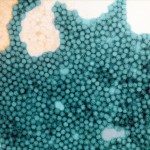Link to Pubmed [PMID] – 2451759
J. Virol. 1988 May;62(5):1836-9
Insertion of a synthetic DNA fragment encoding a poliovirus neutralization epitope into the S gene encoding the major envelope protein of hepatitis B virus has yielded hybrid (HBsPolioAg) particles closely resembling authentic 22-nm antigen (HBsAg) particles by expression of the modified gene in mammalian cells. In mice, these hybrid particles induce neutralizing antibodies against poliovirus but only weak immune response to HBsAg (F. Delpeyroux, N. Chenciner, A. Lim, Y. Malpièce, B. Blondel, R. Crainic, S. Van der Werf, and R. E. Streeck, Science 233:472-474, 1986). By cotransfection with different plasmids carrying either modified or unmodified S genes, we have now obtained mixed particles presenting both HBsAg and HBsPolioAg. When such particles were inoculated into rabbits, antibodies to both poliovirus and to HBsAg were induced. Moreover, the titers of neutralizing antibodies to poliovirus induced by HBsPolioAg were much higher than those previously obtained in mice. The design of multivalent particles carrying various peptide sequences or presenting several heterologous epitopes may therefore be possible.
